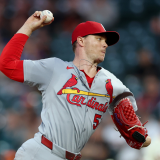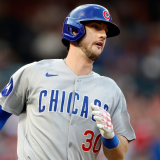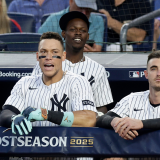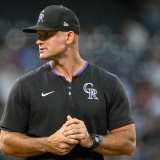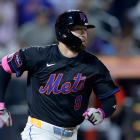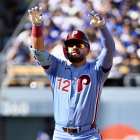Three free-agent relievers who could be converted to starting pitchers -- and why each has a chance to work
Garrett Crochet, Clay Holmes, Seth Lugo and others have all made the move recently. Who could be next?

With quality starting pitching increasingly hard to find these days, teams have turned to the bullpen for help. Relievers carry a much heavier workload now than they did even 10 years ago, that's for sure, but it's more than that. Teams are turning relievers -- good relievers -- into starting pitchers. The Rangers did this way back in the day with C.J. Wilson. More recently it has been done successfully with Garrett Crochet, Clay Holmes, Michael King, Zack Littell, Michael Lorenzen, Seth Lugo, and Jeffrey Springs.
This is not an entirely new concept, of course. Teams have stretched relievers out in spring training for decades because why not? Spring training is the time to try new things and it's much easier to go from starter to reliever at the end of camp than the other way around. Those past reliever-to-starter conversions did not work often, but with teams being so good at pitch design now, the success rate has gone up. It helps that they're only asking these guys to go through the lineup twice and not pitch seven innings.
"Especially with the expectation starters may not have to go three times through the order, this may become more common," one executive told MLB.com in 2024. "I also think as teams have gotten better at optimizing pitch shapes, more teams will try and tweak or add a third pitch that previously prevented a reliever from starting."
Last offseason, the Mets signed Holmes, a two-time All-Star closer, and turned him into a starter. It was a success -- Holmes threw 165 ⅔ innings with a 3.53 ERA -- although he did seem to run out of gas late in the season, which is understandable. The offseason before that, the Giants tried it with Jordan Hicks. That didn't go so well. The offseason before that, it was the Padres with Lugo, a smashing success and kicked this trend into overdrive.
The scarcity of starting pitching has driven this trend and so has economics. Starters make less than relievers, so if you can get a starter at a reliever's salary, you've come out ahead. Holmes signed a three-year contract worth $38 million, which is closer money. Established starters like Yusei Kikuchi and Luis Severino signed for nearly twice as much over the same number of years, and Holmes was as effective if not better. And if it didn't work, the Mets would've put Holmes right back in the bullpen.
In the early days of the offseason, there are rumblings about teams looking at free-agent relievers for potential starting roles. They identify pitchers who have a strong foundation already in place and also areas they believe they can improve. That often means adding a new pitch (Holmes added a changeup with the Mets), though it could also be a delivery adjustment or a change in pitch mix. Here now are three free-agent relievers who could make the jump into the rotation in 2026.
RHP Ryan Helsley
Free-agent rank: No. 24 (fifth among relievers)
History as a starter: Minimal. Helsley started in college and his first three years in the minors, but that was it. The Cardinals moved him to the bullpen in Triple-A in 2019, he made his MLB debut that April, and he never looked back. Helsley, now 31, has never started a game in the big leagues because he was too dominant in the late innings. There were persistent whispers about trying Helsley in the rotation during his time in St. Louis, but they never went through with it.
His arsenal: For all intents and purposes, Helsley is a four-seamer/slider pitcher who uses them at a near 50/50 split. He will mix in the occasional curveball and he toyed briefly with a cutter early in 2025, though that didn't stick. Go back to 2019-22 and Helsley would break out a sinker and a changeup now and then, but very rarely. We're talking only a handful per year. The feel for spin is there with the curveball. Otherwise, Helsley is a pretty classic four-seamer/slider reliever.
What he needs: Well, for starters, Helsley and his next team have to figure out why his fastball, which still regularly touched triple digits, got blasted in 2025, particularly by right-handed batters. Opponents hit .422 with a .667 slugging percentage against the heater this summer, and the six homers Helsley allowed on the pitch are one more than he gave up on fastballs from 2022-24. It's pretty mystifying, really. Helsley's fastball had its usual velocity and movement in 2025, but the pitch got hit very hard.
With Helsley, it's pretty clear what he needs to do to make a potential transition into the rotation work. He has to fix his fastball, first and foremost, and he must come up with a third pitch. It could be the curveball -- it's not uncommon to see a starter with two breaking balls and no changeup these days -- though I reckon the team that tries starting Helsley (if any team does) will look to expand his arsenal further. Can the cutter, changeup, and curveball all become feature pitches? What about a sinker?
Can it work? I am skeptical about Helsley moving into the rotation because he's never been a great strike-thrower and there's a lot of effort in his delivery, two things that usually don't make for a reliable starter. He's never had much of an issue with lefties, but that was in a one-inning role. Going through a lineup even twice is a much different animal. If Helsley had a typical Helsley season in 2025 and we hadn't seen his high-octane fastball get squared up so often, maybe I'd be more optimistic.
What I think doesn't matter though. Several teams, including the Tigers, have expressed interest in Helsley as a starting pitcher, according to The Athletic. Actual MLB teams think Helsley can start, or, more accurately, they're willing to give him a chance to start as long as the price is right. I will never say a pitcher absolutely cannot make the reliever to starter transition because modern pitcher development is so, so good. Helsley does strike me as a bit of a long shot though.
RHP Brad Keller
Free-agent rank: No. 35 (sixth among relievers)
History as a starter: It is lengthy. In fact, 2025 was Keller's first season as a full-time reliever (he did make one start as an opener). Still only 30, Keller has made 20 starts in a season four times and he even has two Opening Day starts under his belt (2019 and 2021 with the Royals). Injuries and ineffectiveness had him working more of a swingman role from 2022-24, but Keller has been a starter in the big leagues. He knows the routine and what it takes to get through the long grind of a season in that role.
His arsenal: Even as a short reliever with the Cubs this past season, Keller used a starter's arsenal. He throws five distinct pitches and his usage is based on the batter's handedness. Righties saw two fastballs (four-seamer and sinker) and two sliders (sweeper and traditional slider). Lefties got the four-seamer and split-change, plus the occasional traditional slider. Keller threw all five pitches at least 10% of the time each. He pitched like a starter out of the bullpen and had immense success against righties and lefties.
What he needs: The biggest thing is health. Keller already has the deep arsenal you want in a starter, as well as a history of throwing strikes and familiarity with the role. Earlier in his career, Keller sat 92-95 mph with his fastball and scraped 98 mph now and then. This past season, he sat 95-97 mph and topped out at 99 mph. The top-end velocity is about the same, but working shorter stints boosted his average velocity. Keller credited good health and mechanical adjustments in addition to the role change.
Here's what Keller told FanGraphs about his successful 2025 season in September:
"It's being healthy, first and foremost," Keller said of his return to form. "I battled (thoracic outlet syndrome) for a couple years, and it really came to a head two years ago. Ultimately, I had surgery, and I feel better now than I have my entire career. I'm recovering better than I ever had. That along with some tweaks I made mechanically have helped me max my velo. Overall, I'm just a better pitcher. Stuff-wise, sequencing-wise, using my pitches well. There was basically a revamp of everything."
There is always room to tweak a pitcher's arsenal. In Keller's case, he's already working with five offerings, including pitches that are effective against hitters on either side of the plate. He has toyed with a curveball in the past, so maybe he tries to bring that back just to have another look, but it doesn't seem imperative. Keller has been an effective big-league starter in the past. This isn't some far-fetched idea. Really all Keller needs is good health and an opportunity.
Can it work? It's reasonable to expect Keller's velocity to dip working longer outings as a starter. That applies to every pitcher. Even if it goes back into the 92-95 mph range though, Keller has enough tools in his belt to remain effective. He has multiple fastballs and multiple breaking balls, and a split-change hybrid to boot. Not surprisingly, teams have shown interest in Keller as a starting pitcher, per the New York Post. The arsenal and past history suggests this reliever-to-starter conversion would have a real chance to work.
RHP Luke Weaver
Free-agent rank: No. 20 (third among relievers)
History as a starter: Like Keller, Weaver has started most of his career. He's made 25 starts twice (2018 and 2023) and made 12 starts during the 60-game 2020 season. That's a full season's worth. Weaver, 32, did not start a single game in 2024 or 2025. Those are the only two years in his 10 big league seasons that he did not start a game, and even then the Yankees initially used him for multiple innings before Weaver settled into a one-inning, late-inning role. Bottom line, Weaver has started plenty. He's done it.
His arsenal: As a reliever the last two years, Weaver threw 90% four-seamers and changeups, plus the occasional cutter. He went from the low-90s as a starter into the mid-90s as a reliever, and the Yankees tweaked his changeup last year, adding more action downward. It's an excellent changeup, one that neutralizes both lefties and righties, and is Weaver's go-to weapon. The fastball is more than a show-me pitch, but the changeup is the pitch Weaver leans on when he push comes to shove.
What he needs: Weaver has never had a reliable, consistent breaking ball. Not even in college. He's tried different curveball and sliders over the years, sweepers, you name it. Weaver has pitched for six teams in his career and all six have tried to help him come up with a steady spinner. The next team could be the one that does it! Right now though, Weaver is a two-pitch guy, or maybe three pitches if you grade out the cutter generously. The changeup is excellent, but a good breaking ball feels like a must here.
Can it work? Not surprisingly, Weaver is open to starting. "The door is open. I am never going to just say absolutely not," he told the New York Post in September. The fact Weaver, who's been in the league for a decade already, has been unable to come up with a reliable breaking ball makes me skeptical. That is especially true now, in an age in which teams almost literally cook up breaking balls in a lab. It's OK velocity, which equals less margin of error. Weaver appears to face an uphill battle to be a successful starter.








